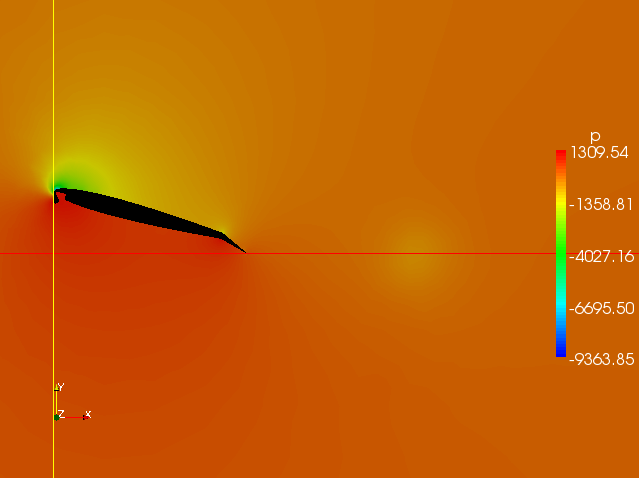starting vortex on:
[Wikipedia]
[Google]
[Amazon]
 In fluid dynamics, the starting vortex is a
In fluid dynamics, the starting vortex is a
 In fluid dynamics, the starting vortex is a
In fluid dynamics, the starting vortex is a vortex
In fluid dynamics, a vortex ( : vortices or vortexes) is a region in a fluid in which the flow revolves around an axis line, which may be straight or curved. Vortices form in stirred fluids, and may be observed in smoke rings, whirlpools in ...
which forms in the air adjacent to the trailing edge of an airfoil as it is accelerated from rest. It leaves the airfoil (which now has an equal but opposite "bound vortex" around it), and remains (nearly) stationary in the flow. It rapidly decays through the action of viscosity
The viscosity of a fluid is a measure of its resistance to deformation at a given rate. For liquids, it corresponds to the informal concept of "thickness": for example, syrup has a higher viscosity than water.
Viscosity quantifies the inte ...
.
The initial (and quite brief) presence of a starting vortex
In fluid dynamics, a vortex ( : vortices or vortexes) is a region in a fluid in which the flow revolves around an axis line, which may be straight or curved. Vortices form in stirred fluids, and may be observed in smoke rings, whirlpools in ...
as an airfoil begins to move was predicted by early aerodynamicists, and eventually photographed.
Whenever the speed or angle of attack of an airfoil changes there is a corresponding amount of vorticity deposited in the wake behind the airfoil, joining the two trailing vortices
Wingtip vortices are circular patterns of rotating air left behind a wing as it generates lift.Clancy, L.J., ''Aerodynamics'', section 5.14 One wingtip vortex trails from the tip of each wing. Wingtip vortices are sometimes named ''trailing' ...
. This vorticity is a continuum of mini-starting-vortexes. The wake behind an aircraft is a continuous sheet of weak vorticity, between the two trailing vortices, and this accounts for the changes in strength of the trailing vortices as the airspeed of the aircraft and angle of attack on the wing change during flight."This starting vortex formation occurs not only when a wing is first set into motion, but also when the circulation around the wing is subsequently changed for any reason whatever." Millikan, Clark B., ''Aerodynamics of the Airplane'', page 65 (The strength of a vortex
In fluid dynamics, a vortex ( : vortices or vortexes) is a region in a fluid in which the flow revolves around an axis line, which may be straight or curved. Vortices form in stirred fluids, and may be observed in smoke rings, whirlpools in ...
cannot change within the fluid except by the dissipative action of viscosity
The viscosity of a fluid is a measure of its resistance to deformation at a given rate. For liquids, it corresponds to the informal concept of "thickness": for example, syrup has a higher viscosity than water.
Viscosity quantifies the inte ...
. Vortices either form continuous loops of constant strength, or they terminate at the boundary of the fluid - usually a solid surface such as the ground.)
The starting vortex is significant to an understanding of the Kutta condition
The Kutta condition is a principle in steady-flow fluid dynamics, especially aerodynamics, that is applicable to solid bodies with sharp corners, such as the trailing edges of airfoils. It is named for German mathematician and aerodynamicist Mart ...
and its role in the circulation around any airfoil generating lift
Lift or LIFT may refer to:
Physical devices
* Elevator, or lift, a device used for raising and lowering people or goods
** Paternoster lift, a type of lift using a continuous chain of cars which do not stop
** Patient lift, or Hoyer lift, mobil ...
.
The starting vortex has certain similarities with the "starting plume" which forms at the leading edge of a slug of fluid, when one fluid is injected into another at rest. See plume (hydrodynamics)
In hydrodynamics, a plume or a column is a vertical body of one fluid moving through another. Several effects control the motion of the fluid, including momentum (inertia), diffusion and buoyancy (density differences). Pure ''jets'' and pure ''p ...
.
References
*L. J. Clancy
Laurence Joseph Clancy (15 March 1929 - 16 October 2014) was an Education Officer in aerodynamics at Royal Air Force College Cranwell whose textbook ''Aerodynamics'' became standard.
He was born in Egypt to Alfred Joseph Clancy and Agnes Hunter. I ...
(1975), ''Aerodynamics'', Section 4.8, Pitman Publishing Limited, London
* Millikan, Clark B., ''Aerodynamics of the Airplane'', Section 1–6, eighth printing, John Wiley and Sons, Inc., (1941) New York.
* Massey, B.S., ''Mechanics of Fluids'', Section 9.10, 2nd Edition. Van Nostrand Reinhold Co., London (1970) Library of Congress Catalog Card No. 67-25005
Notes
See also
* Helmholtz's theorems *Kutta condition
The Kutta condition is a principle in steady-flow fluid dynamics, especially aerodynamics, that is applicable to solid bodies with sharp corners, such as the trailing edges of airfoils. It is named for German mathematician and aerodynamicist Mart ...
* Kutta–Joukowski theorem
The Kutta–Joukowski theorem is a fundamental theorem in aerodynamics used for the calculation of lift of an airfoil (and any two-dimensional body including circular cylinders) translating in a uniform fluid at a constant speed large enough so ...
* Wake turbulence
Wake turbulence is a disturbance in the atmosphere that forms behind an aircraft as it passes through the air. It includes variety of elements, the most significant of which are wingtip vortices and jetwash. Jetwash refers to the rapidly moving g ...
{{Authority control
Aerodynamics
Vortices